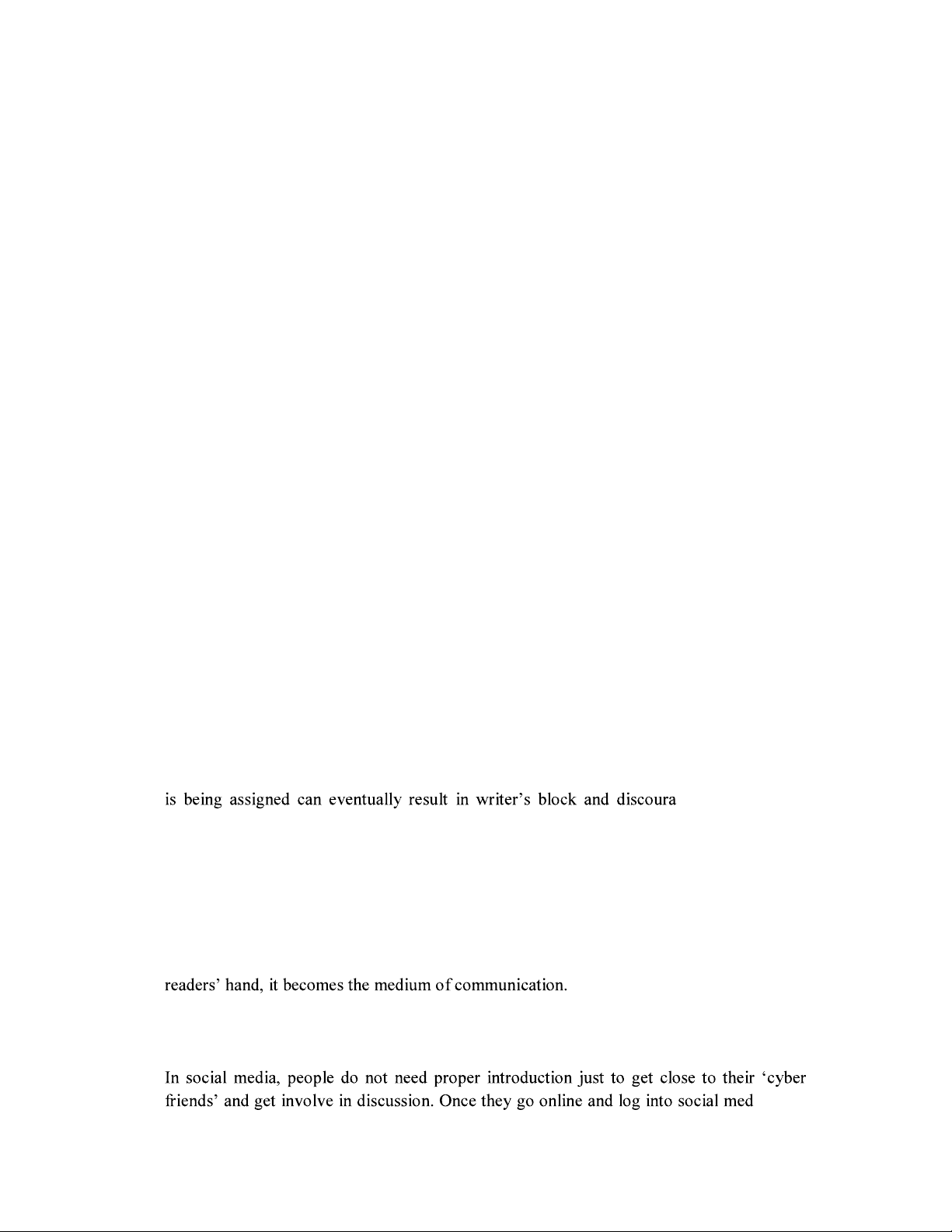
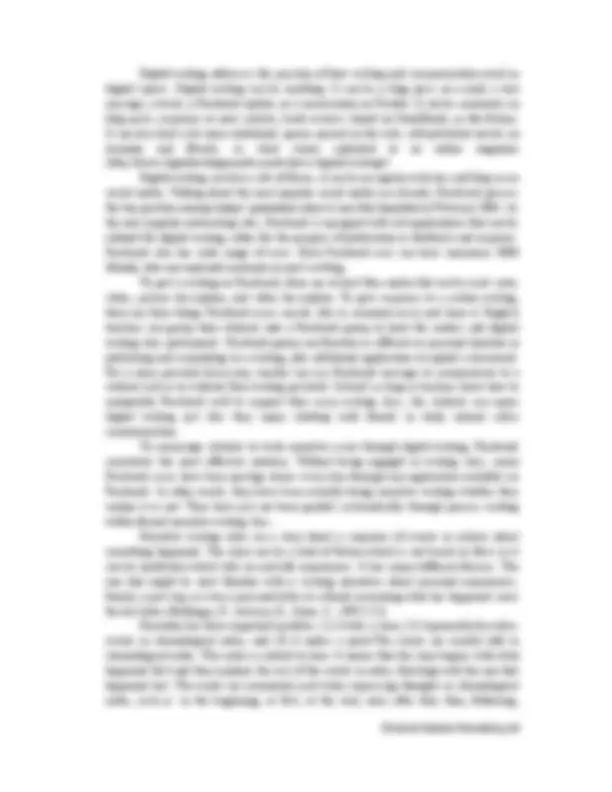
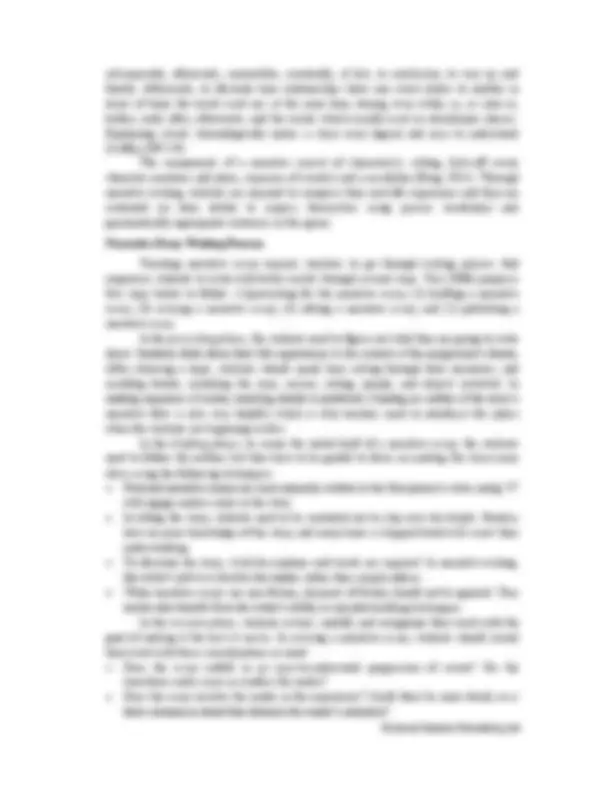
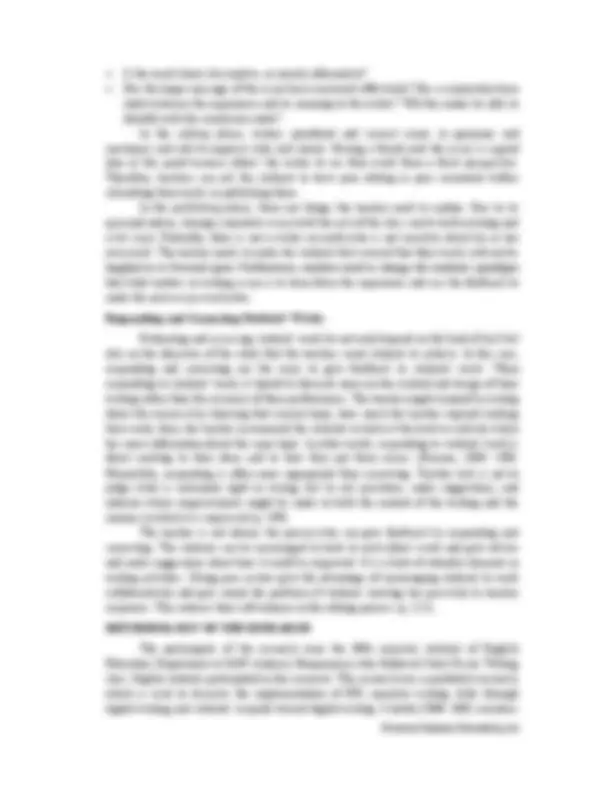
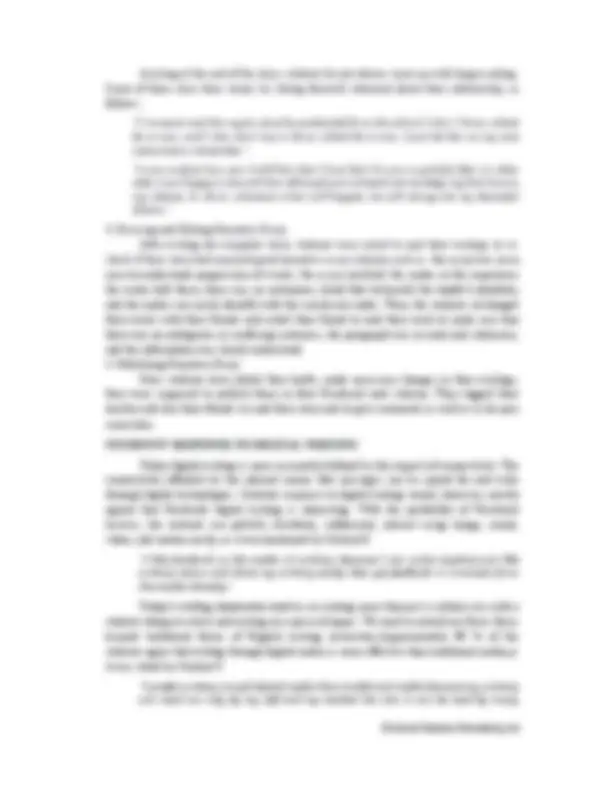
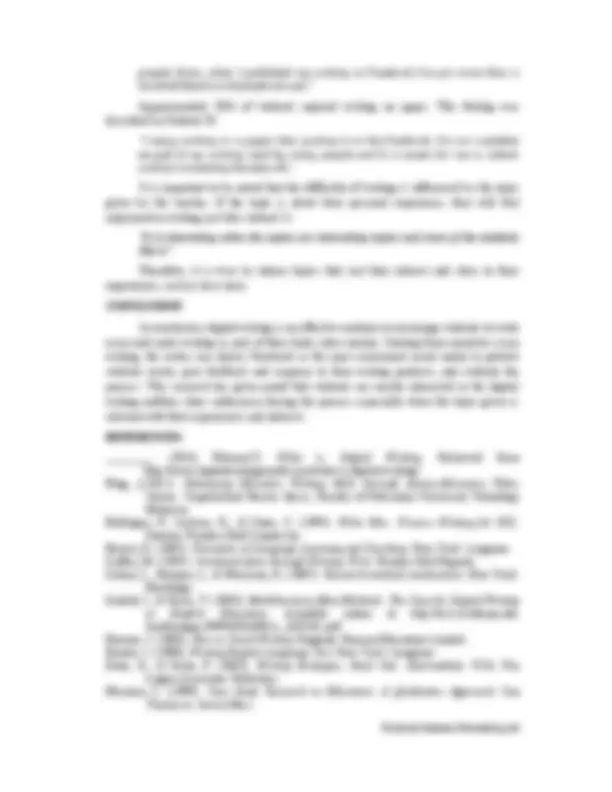
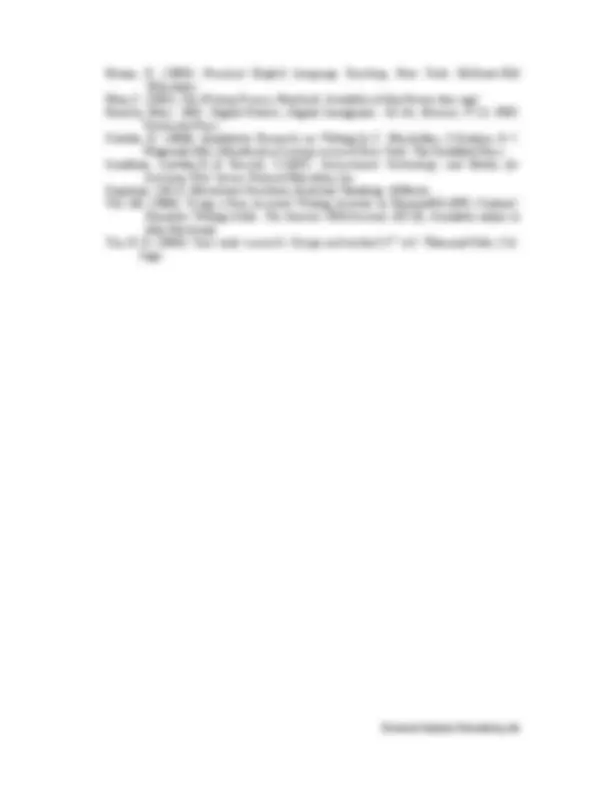


Study with the several resources on Docsity

Earn points by helping other students or get them with a premium plan


Prepare for your exams
Study with the several resources on Docsity

Earn points to download
Earn points by helping other students or get them with a premium plan
Community
Ask the community for help and clear up your study doubts
Discover the best universities in your country according to Docsity users
Free resources
Download our free guides on studying techniques, anxiety management strategies, and thesis advice from Docsity tutors
gradually part of their life. English teachers can start with narrative writing, which seem to be one of the lightest challenges in writing since it ...
Typology: Slides
1 / 10

This page cannot be seen from the preview
Don't miss anything!







Afifah Linda Sari, Nur Alfa Rahmah IAIN Antasari Banjarmasin Abstract The development of technology gives English teachers a great deal of opportunities to provide their learners with a lot of help in writing in a form of internet-based resources. The media to publish students' writing have also broadened to digital world, or also known as digital writing. The growing popularity of social network services among adolescents can be utilized to promote digital writing as an effective medium to encourage students in writing as well as enhancing their writing skill then to offer them chances to produce writing in real-life situated contexts to cyber societies. Through social network, such as facebook, the students can get immediate comments and feedback from their friends and enjoy writing as much as socializing with their cyber friends. In this research, the researchers investigate the efficacy of digital writing to encourage students to write narrative essay. The students' response and enthusiasm to the approach are also analyzed to support the findings. Key words: narrative essay, digital writing, students' response INTRODUCTION Writing essay is a kind of skill that requires not only rich ideas but also good organization, not to mention the language structures that should be noted by every writer to produce a good quality writing. This kind of presumption often times haunt English learners during writing. They also feel anxious knowing that their writing will be formally graded by the teacher. All these conditions and lack of information about certain topic that gement in writing essay. To encourage students to write essay, English teachers need to create certain atmosphere and perception that writing is easy and fun, and that writing is all about telling or communicating what we think, we feel, we believe, and we experience in life. In fact, that is what everybody does every day; they communicate with their acquaintance, friends, and relatives, and exchanging perceptions about life, people, and the like. Writing has the same kind of conception, only that it is in written form. Once a piece of writing is in the Nowadays in digital era, we are connected by technology, which makes communication among people easier. People communicate via SMS, line, Facebook, WhatsApp and all social media without even knowing well the people they communicate. ia, they
has the right to read it and comment on it. ideas can be published to digital world without typing, and the closest generation to digital their friends and acquaintances through their smartphone screen almost every hour (Prensky, 2001). In other words, they are writing every day; they do digital writing without even realizing it. The best part of this phenomenon is that these teenagers never really run out of ideas to tell what is in their mind to their cyber friends. If we connect what teenagers do on the internet with essay writing, we can say that digital writing is the best medium to encourage students to write. This is the part where teacher can introduce essay writing as something challenging yet fun and make writing gradually part of their life. English teachers can start with narrative writing, which seem to be one of the lightest challenges in writing since it consists of stories that can be related to mediate publication and get fast response or feedback from their cyber readers without feeling that they are formally graded by their teachers. In brief, digital literacy nowadays possesses important part in the success of second language learning. This is not only because digital media especially internet has become secondary if not the primary sources of information, but also popular medium of learning and communication. NARRATIVE ESSAY THROUGH DIGITAL WRITING Writing is a complex process to a composition of words resulting from the exploration of thoughts and idea, drafted into written text, and subsequently revised to ensure that the writing product can clearly be understood by readers (Nunan, 2003:88, Brown, 2007:391). It indicates that writing refers to the way a writer composes a text as written communication between writers and readers. Some consideration in producing writing proposed by experts are as follows: content (ideas), organization, language use (grammar), mechanics, and word choiceorvocabulary (Brown, 2007:39, Peha, 2002, and Heaton, 1988:135). Teaching essay writing will be most effective when teachers choose student- centered activities because they can spend more time diagnosin problems and consult with individual students. Technology and media also help to efficiently save the time. It will spend much time if English teachers deny the extent of the instructional role assigned to technology and media during teaching writing (Smaldino, Lowther, and Russell, 2007:13). It is generally accepted that computers now are not merely tools for writing but have changed the processes, products, and contexts for writing. It is also generally accepted that teaching writing in technological environments, both physical and virtual, is quite different from teaching in environments mediated by more traditional technologies. digital refer to a changed writing environment which is produced by the computer and distributed via networks (Grabill and Hicks, 2005).
subsequently, afterwards, meanwhile, eventually, at last, in conclusion, to sum up and finally. Afterwards, to illustrate time relationships (how one event relates to another in terms of time) the words used are: at the same time, during, wen, while, as, as soon as, before, until, after, afterwards, and the words which usually used in subordinate clauses. Explaining events chronologically makes a story seem logical and easy to understand (Coffey,1987:19). The components of a narrative consist of character(s), setting, kick-off event, character emotions and plans, sequence of event(s) and a resolution (Bing, 2011). Through narrative writing, students are required to compose their real-life experience and they are evaluated on their ability to express themselves using precise vocabulary and grammatically appropriate sentences in this genre. Narrative Essay Writing Process Teaching narrative essay requires teachers to go through writing process that empowers students to write with better results through several steps. Teo (2006) proposes five steps below to follow: (1)prewriting for the narrative essay, (2) drafting a narrative essay, (3) revising a narrative essay, (4) editing a narrative essay, and (5) publishing a narrative essay. In the prewriting phase, the students need to figure out what they are going to write about. After choosing a topic, students should spend time sorting through their memories, and recalling details, including the year, season, setting, people, and objects involved. In narrative flow is also very helpful, which is why teachers need to introduce this phase when the students are beginning writers. In the drafting phase, to create the initial draft of a narrative essay, the students need to follow the outline, but they have to be guided to focus on making the story come alive, using the following techniques: will engage readers more in the story. In telling the story, students need to be reminded not to skip over the details. Readers have no prior knowledge of the story, and many times a skipped detail will screw their understanding. To illustrate the story, vivid descriptions and words are required. In narrative writing, ther than simply inform. While narrative essays are non-fiction, elements of fiction should not be ignored. True -building techniques. In the revision phase, students review, modify, and reorganize their work with the goal of making it the best it can be. In revising a narrative essay, students should reread their work with these considerations in mind: Does the essay unfold in an easy-to-understand progression of events? Do the transitions make sense or confuse the reader? Does the essay involve the reader in the experience? Could there be more detail, or is
Is the word choice descriptive, or merely informative? Has the larger message of the essay been conveyed effectively? Has a connection been made between the experience and its meaning to the writer? Will the reader be able to identify with the conclusion made? In the editing phase, writers proofread and correct errors in grammar and mechanics and edit to improve style and clarity. Having a friend read the essay is a good idea at this point because allows the writer to see their work from a fresh perspective. Therefore, teachers can ask the students to have peer editing or peer comments before submitting their works or publishing them. In the publishing phase, there are things the teacher need to realize. Due to its personal nature, sharing a narrative essay with the rest of the class can be both exciting and a bit scary. Naturally, there is not a writer on earth who is not sensitive about his or her own work. The teacher needs to make the students feel secured that their works will not be that what matters in writing essay is to learn from the experience and use the feedback to make the next essay even better. Responding and Correcting s Evaluating and assessing students' work do not only depend on the kind of task but also on the objective of the study that the teachers want students to achieve. In this case, responding and correcting are the ways to give feedback to students' work. When responding to students' work, it should be focused more on the content and design of their writing rather than the accuracy of their performance. The teacher might respond by asking about the reason why choosing that current topic, how much the teacher enjoyed reading their work, then, the teacher recommend the students to look at the book or website which has more information about the same topic. In other words, responding to students' work is about reacting to their ideas and to how they put them across (Harmer, 2004: 108). Meanwhile, responding is often more appropriate than correcting. Teacher task is not to judge what is extremely right or wrong, but to ask questions, make suggestions, and indicate where improvements might be made to both the content of the writing and the manner in which it is expressed (p. 109). The teacher is not always the person who can give feedback by responding and correcting. The students can be encouraged to look at each other's work and give advice and make suggestions about how it could be improved. It is a kind of valuable elements in writing activities. Doing peer review give the advantage of encouraging students to work collaboratively and gets round the problem of students reacting too passively to teacher responses. This reduces their self-reliance in the editing process (p. 115). METHODOLOGY OF THE RESEARCH The participants of the research were the fifth semester students of English Education Department at IAIN Antasari Banjarmasin who followed Short Essay Writing class. Eighty students participated in this research. This research was a qualitative research, which is used to discover the implementation of EFL narrative writing skills through digital writing and students' respond toward digital writing. Schultz (2006: 369) considers
the purpose of their writing, the audience they are writing for, and the content structure of the piece. In this case, the purposes of their writing were sharing their personal experience and taking positive value from the story. The audience are digital readers, and the content structure consisted of the fact, ideas, and argument which they have decided to include in their writing.
Arriving at the end of the story, students do not always come up with happy ending. Some of them close their stories by stating farewell statement about their relationship, as follows: "Ive never met him again since he graduated from the school. I dont know where he is now, and I also don't try to know where he is now. I just let him as my nice memorize to remember." "I was confuse how can I told him that I love him? It was so painful. But, in other side, I was happy to be with him although just a friend. Let me keep my first love in my silence. In short, whatever what will happen, he will always be my beautiful dream."
Nunan, D. (2003). Practical English Language Teaching. New York: McGraw-Hill Education. Peha, S. (2002). The Writing Process Notebook. Avalaible at http://www.ttms.org/. Prensky, Marc. 2001. Digital Natives, Digital Immigrants. On the Horizon, 9 (5). NBC University Press. Schultz, K. (2006). Qualitative Research on Writing.In C. MacArthur, S.Graham & J. Fitzgerald (Eds.)Handbook of writing research.New York: The Guildford Press. Smaldino, Lowther,D.,& Russell, J.(2007). Instructional Technology and Media for Learning. New Jersey: Pearson Education, Inc. Sugiyono. (2012). Memahami Penelitian Kualitatif. Bandung: Alfabeta. Teo AK (2006). Using a Peer Assisted Writing Activity to PromoteESL/EFL Students' Narrative Writing Skills. The Internet TESLJournal, XII (8). Available online at http://iteslj.org/. Yin, R. K. (2003). Case study research: Design and method ( rd ed.). Thousand Oaks, CA: Sage.